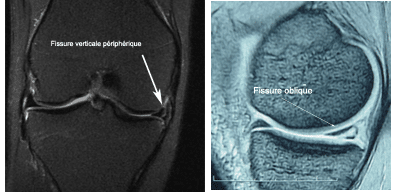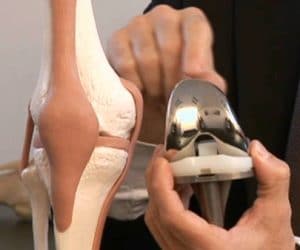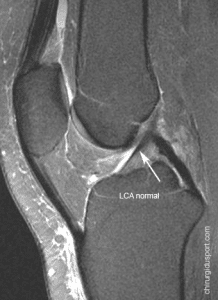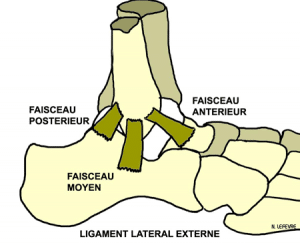What is a meniscus?

The meniscus is semilunar fibrocartilage (orange area) triangular cut. Each knee has two menisci, a medial meniscus and a lateral meniscus.
They are “shock absorbers” of the knee: they have a role in the transmission and distribution constraints. They increase joint congruency and stabilization of the knee. They allow shock absorption and protection of cartilage.
The preservation of capital is fundamental meniscal and prevent joint destruction.
What is the harm?

Among the young athlete, most meniscal lesions are secondary to significant trauma on a healthy meniscus. This is in compression trauma, bending or torsion. They may be associated with damage to the anterior cruciate ligament (ACL). The most common injuries or meniscal tears are: vertical or radial cracks, the tongue or the bucket handle.
In the older sports, the concept of trauma is rare. This is most often repetitive strain injury by (jogging) on ??degenerative meniscus. This lack of risk triggering factor to ignore the diagnosis. Knee pain and / or synovial effusion should suggest the diagnosis. These meniscal lesions (complex crack and tongue) induced by their irregularities impaired wearer cartilage.
How to diagnose?
A meniscal lesion is often very painful, with swelling (joint effusion), and sometimes a knee lock, Diagnosis is by examination and clinical examination, the diagnosis is confirmed by MRI.

What is the treatement ?

Among the young athlete, it must favor the meniscal economy: repair by suture arthroscopic meniscus is often possible. If the anterior cruciate ligament injury ligamentoplasty is performed at the same time.
The prognosis of a meniscal repair depends on several factors:
- patient age (better in children than adults)
- the age of the lesion (more favorable if <3 months)
- stability of the knee (ACL repair associated)
- the location of the lesion (peripheral meniscus)
In the older patient, meniscal suture is not indicated.
Medical treatment with anti-inflammatory and analgesic should be prescribed. It relieves many patients. If persistent or worsening symptoms, arthroscopic surgery is required and gives excellent results.
This is to regulate the minimum meniscal tear (partial meniscectomy) using small instruments inserted into the knee under video control (arthroscopy)
Question: Many patients wonder if warranted removing the meniscus is not it necessary?

Indeed, the meniscus plays an important role in the knee. Nevertheless a meniscal lesion reduces the properties of it (broken shock absorber). In addition, complex cracks, bucket handle tongue and induce their irregularities impaired cartilage carrier: today, one no longer withdraw the entire meniscus but partial removal is carried out.
Arthroscopy (suture or partial meniscectomy) is the preferred treatment of these lesions.
Doctor Nicolas LEFEVRE, Doctor Serge HERMAN, Doctor Yoann BOHU. – 13 février 2012.



